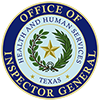OIG initiatives drive fraud investigations
The OIG’s work to uncover fraud, waste and abuse in health care delivery often begins with referrals from MCOs, providers and clients. The OIG receives more than 200 referrals each day through ReportTexasFraud.com and the OIG Fraud Hotline. The OIG also self-initiates cases based on data analytics or trends seen by its investigators. This approach involves teams across the OIG, including the Intake Resolution Unit (preliminary investigation), Policy & Strategic Initiatives (policy clarifications), Medical Services (consultations), the Fraud, Waste, and Abuse Research and Analytics (certified paid claims analysis), Provider Investigations (case investigation) and Litigation (guidance and resolution). Together, these groups employ a variety of research, analytical tools and strategies to identify potential wrongdoing by Medicaid health care providers.
The initiative cases are cases that have not been worked before. An initiative is based on extensive research identifying potential violations and the applicability of policy, statutes and contracts. The research includes identifying coding limitations in the Healthcare Common Procedure Coding System, Texas Medicaid & Healthcare Partnership, and the Texas Medicaid Provider Procedures Manual; reading up on what is happening in other states, specifically in the National Health Care Anti-Fraud Association's SmartBrief; analyzing referrals and complaints received by the OIG; performing internet searches; and reading OIG audits and MCO provider manuals.
Once the evidence identifies an issue for an initiative case, OIG staff analyze data to identify any providers exhibiting the behavior in the initiative. Data mining is performed to reveal the claims that do not follow policy. Finally, the case is presented to the provider for resolution of overpayments.
The following are types of active initiative cases:
- Electroencephalographic (EEG) services. Neurologists and other clinicians are billing for an EGG EEG service which requires 24-hour monitoring by a clinician who can intervene in the monitoring and/or patient care as needed. The OIG initiative identified providers who are equipping patients with mobile EEG units and sending them home for overnight monitoring without 24-hour monitoring by a clinician. As a result, the providers inappropriately received a higher reimbursement amount.
- Hospital ER injection/infusions cases. The initiative monitors data to identify hospital outpatient facilities that billed and were paid separately for injections/infusions when the same services were already covered by another billing code paid on the same dates of service. Additionally, the administration of an injection is not reimbursable to outpatient hospital providers.
- Laboratory improvement amendments (CLIA) initiative. The CLIA initiative is designed to identify independent laboratories that received payment for specific types of testing without holding the appropriate CLIA certification to perform such testing. CLIA regulations set standards that are designed to improve quality in all laboratory testing and include specifications for quality control, quality assurance, patient test management, personnel and proficiency testing.
- Non-covered services. This initiative monitors data to identify providers that are billing and being reimbursed for services that, per the Texas Medicaid Provider Procedures Manual and the Healthcare Common Procedure Coding System, are not covered benefits of the Texas Medicaid Program and/or are not covered by the contracted MCO.
- Private duty nursing cases. In this initiative, the investigator identified providers that were billing over the daily allowable amount of units of private duty nursing. A home health agency must bill private duty nursing in 15-minute increments, not to exceed 96 units per day. The OIG identified providers that billed and were reimbursed for more than 96 units on a single date of service for one patient.
- Critical care cases. These cases involve a patient receiving emergency room services at a lower level and the hospital billing for a higher level, such as for (Critical Care). As a result, the provider inappropriately receives a higher reimbursement amount.
The OIG works with providers to resolve cases and prevent further occurrences of wrongdoing. Initiatives also may provide opportunities for fraud prevention through education.

